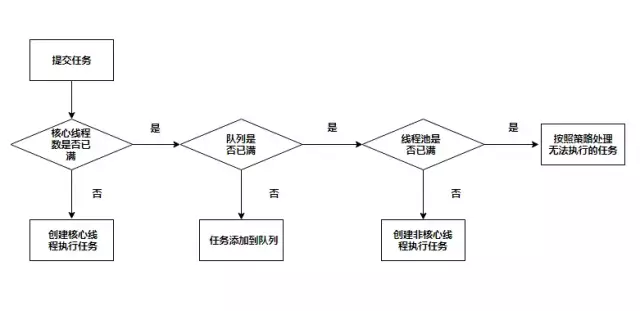合理利用线程池能够带来三个好处
第一:降低资源消耗。通过重复利用已创建的线程降低线程创建和销毁造成的消耗。
第二:提高响应速度。当任务到达时,任务可以不需要的等到线程创建就能立即执行。
第三:提高线程的可管理性。线程是稀缺资源,如果无限制的创建,不仅会消耗系统资源,还会降低系统的稳定性,使用线程池可以进行统一的分配,调优和监控。但是要做到合理的利用线程池,必须对其原理了如指掌
线程池的主要工作流程

执行逻辑说明:
判断核心线程数是否已满,核心线程数大小和corePoolSize参数有关,未满则创建线程执行任务
若核心线程池已满,判断队列是否满,队列是否满和workQueue参数有关,若未满则加入队列中
若队列已满,判断线程池是否已满,线程池是否已满和maximumPoolSize参数有关,若未满创建线程执行任务
若线程池已满,则采用拒绝策略处理无法执执行的任务,拒绝策略和handler参数有关
线程池的创建
我们可以通过ThreadPoolExecutor来创建一个线程池。
new ThreadPoolExecutor(corePoolSize, maximumPoolSize, keepAliveTime, milliseconds,runnableTaskQueue, threadFactory,handler);
创建一个线程池需要输入几个参数:
corePoolSize - 线程池核心池的大小。 maximumPoolSize - 线程池的最大线程数。 keepAliveTime - 当线程数大于核心时,此为终止前多余的空闲线程等待新任务的最长时间。 unit - keepAliveTime 的时间单位。 workQueue - 用来储存等待执行任务的队列。 threadFactory - 线程工厂。 handler - 拒绝策略。
参数的英文解释:
* @param corePoolSize the number of threads to keep in the pool, even * if they are idle, unless {@code allowCoreThreadTimeOut} is set * @param maximumPoolSize the maximum number of threads to allow in the * pool * @param keepAliveTime when the number of threads is greater than * the core, this is the maximum time that excess idle threads * will wait for new tasks before terminating. * @param unit the time unit for the {@code keepAliveTime} argument * @param workQueue the queue to use for holding tasks before they are * executed. This queue will hold only the {@code Runnable} * tasks submitted by the {@code execute} method.
轻松理解corePoolSize与maxPoolSize:
我们可以把 corePoolSize 与 maxPoolSize 比喻成长工与临时工,通常古代一个大户人家会有几个固定的长工,负责日常的工作,而大户人家起初肯定也是从零开始雇佣长工的。
假如长工数量被老爷设定为 5 人,也就对应了 corePoolSize,不管这 5 个长工是忙碌还是空闲,都会一直在大户人家待着,可到了农忙或春节,长工的人手显然就不够用了,这时就需要雇佣更多的临时工,这些临时工就相当于在 corePoolSize 的基础上继续创建新线程,但临时工也是有上限的,也就对应了maxPoolSize,随着农忙或春节结束,老爷考虑到人工成本便会解约掉这些临时工,家里工人数量便会从maxPoolSize降到corePoolSize,所以老爷家的工人数量会一致保持在corePoolSize 和 maxPoolSize 的区间。
为什么线程池不允许使用Executors去创建
阿里巴巴java开发手册有这么一句话:“线程池不允许使用Executors去创建,而是通过ThreadPoolExecutor的方式,这样的处理方式让写的同学更加明确线程池的运行规则,规避资源耗尽的风险”
Executors创建返回ThreadPoolExecutor对象的方法共有三种:
Executors#newCachedThreadPool => 创建可缓存的线程池 Executors#newSingleThreadExecutor => 创建单线程的线程池 Executors#newFixedThreadPool => 创建固定长度的线程池
Executors#newCachedThreadPool方法
public static ExecutorService newCachedThreadPool() { return new ThreadPoolExecutor(0, Integer.MAX_VALUE, 60L, TimeUnit.SECONDS, new SynchronousQueue<Runnable>()); }
CachedThreadPool是一个根据需要创建新线程的线程池
corePoolSize => 0,核心线程池的数量为0 maximumPoolSize => Integer.MAX_VALUE,可以认为最大线程数是无限的 keepAliveTime => 60L unit => 秒 workQueue => SynchronousQueue
当一个任务提交时,corePoolSize为0不创建核心线程,SynchronousQueue是一个不存储元素的队列,可以理解为队里永远是满的,因此最终会创建非核心线程来执行任务。
对于非核心线程空闲60s时将被回收。因为Integer.MAX_VALUE非常大,可以认为是可以无限创建线程的,在资源有限的情况下容易引起OOM异常
Executors#newSingleThreadExecutor方法
public static ExecutorService newSingleThreadExecutor() { return new FinalizableDelegatedExecutorService (new ThreadPoolExecutor(1, 1, 0L, TimeUnit.MILLISECONDS, new LinkedBlockingQueue<Runnable>())); }
SingleThreadExecutor是单线程线程池,只有一个核心线程
corePoolSize => 1,核心线程池的数量为1 maximumPoolSize => 1,只可以创建一个非核心线程 keepAliveTime => 0L unit => 秒 workQueue => LinkedBlockingQueue
当一个任务提交时,首先会创建一个核心线程来执行任务,如果超过核心线程的数量,将会放入队列中,因为LinkedBlockingQueue是长度为Integer.MAX_VALUE的队列,可以认为是无界队列,因此往队列中可以插入无限多的任务,在资源有限的时候容易引起OOM异常,同时因为无界队列,maximumPoolSize和keepAliveTime参数将无效,压根就不会创建非核心线程
Executors#newFixedThreadPool方法
public static ExecutorService newFixedThreadPool(int nThreads) { return new ThreadPoolExecutor(nThreads, nThreads, 0L, TimeUnit.MILLISECONDS, new LinkedBlockingQueue<Runnable>()); }
FixedThreadPool是固定核心线程的线程池,固定核心线程数由用户传入
corePoolSize => 1,核心线程池的数量为1 maximumPoolSize => 1,只可以创建一个非核心线程 keepAliveTime => 0L unit => 秒 workQueue => LinkedBlockingQueue 它和SingleThreadExecutor类似,唯一的区别就是核心线程数不同,并且由于使用的是LinkedBlockingQueue,在资源有限的时候容易引起OOM异常
总结:
FixedThreadPool和SingleThreadExecutor => 允许的请求队列长度为Integer.MAX_VALUE,可能会堆积大量的请求,从而引起OOM异常
CachedThreadPool => 允许创建的线程数为Integer.MAX_VALUE,可能会创建大量的线程,从而引起OOM异常
这就是为什么禁止使用Executors去创建线程池,而是推荐自己去创建ThreadPoolExecutor的原因
线程池创建方式(推荐)
根据阿里巴巴java开发规范,推荐了3种线程池创建方式
推荐方式1:
首先引入:commons-lang3包
ScheduledExecutorService executorService = new ScheduledThreadPoolExecutor(1, new BasicThreadFactory.Builder().namingPattern("example-schedule-pool-%d").daemon(true).build());
推荐方式 2:
首先引入:com.google.guava包
ThreadFactory namedThreadFactory = new ThreadFactoryBuilder() .setNameFormat("demo-pool-%d").build(); //Common Thread Pool ExecutorService pool = new ThreadPoolExecutor(5, 200, 0L, TimeUnit.MILLISECONDS, new LinkedBlockingQueue<Runnable>(1024), namedThreadFactory, new ThreadPoolExecutor.AbortPolicy()); pool.execute(()-> System.out.println(Thread.currentThread().getName())); pool.shutdown();//gracefully shutdown
推荐方式 3:
spring配置线程池方式:自定义线程工厂bean需要实现ThreadFactory,可参考该接口的其它默认实现类,使用方式直接注入bean
调用execute(Runnable task)方法即可
<bean id="userThreadPool" class="org.springframework.scheduling.concurrent.ThreadPoolTaskExecutor"> <property name="corePoolSize" value="10" /> <property name="maxPoolSize" value="100" /> <property name="queueCapacity" value="2000" /> <property name="threadFactory" value= threadFactory /> <property name="rejectedExecutionHandler"> <ref local="rejectedExecutionHandler" /> </property> </bean> //in code userThreadPool.execute(thread);